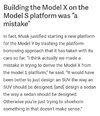It appears from multiple posts that the Rev D hardware isn't a permanent fix for the dreaded shudder. This means all MX owners may be stuck paying $2K/year (10-15K miles) in perpetuity for their vehicles, or alternatively learn to accept the issue.
This doesn't seem to be a sustainable long term option for the Model X platform. Would it be feasible to think if they are redesigning some of the motor design for Model X Plaid that they'd ensure they resolve this issue too? Otherwise I wonder if Tesla considers end of life for the MX as the MY takes off, then re-releases some new SUV off the Cyber Truck. These warranty claims are going to cost them a ton otherwise...
This doesn't seem to be a sustainable long term option for the Model X platform. Would it be feasible to think if they are redesigning some of the motor design for Model X Plaid that they'd ensure they resolve this issue too? Otherwise I wonder if Tesla considers end of life for the MX as the MY takes off, then re-releases some new SUV off the Cyber Truck. These warranty claims are going to cost them a ton otherwise...




